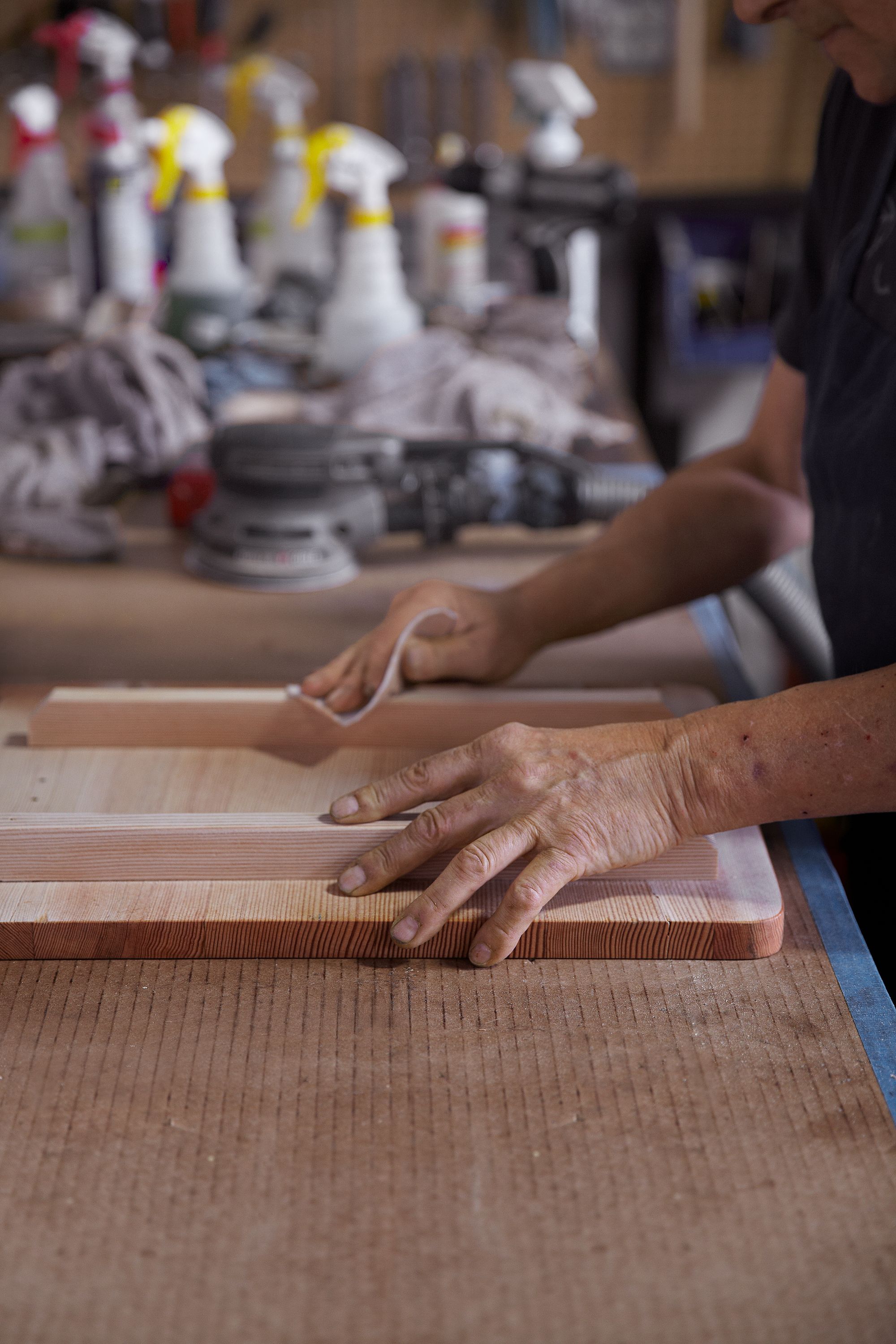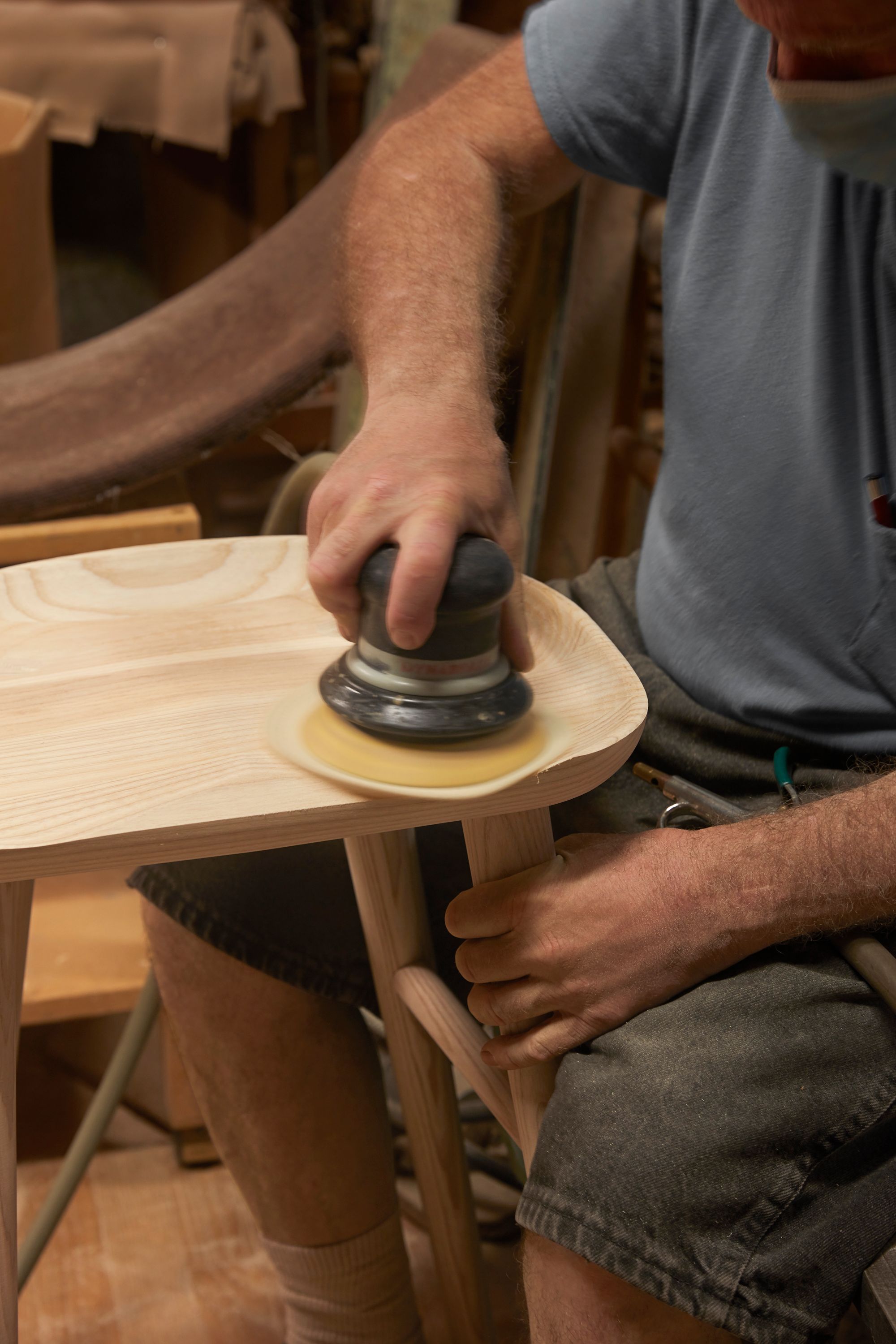Whether it’s a modern coffee table or a matching dining room set, adding handcrafted solid wood furniture into your home makes a statement. From walnut to white oak, our furniture collections are carefully crafted from responsibly sourced North American hardwoods and designed to last. In this guide, we’ll breakdown all of the different wood types we use along with tips on how to care for your special pieces.
Solid Walnut
Heavy, hard, and strong, American walnut is in a class by itself. One of the scarcest and most coveted native hardwoods, walnut is regarded for its high shock resistance, an perfect for carving and intricate woodwork. It’s an excellent choice for an ornate piece like a decorative headboard or buffet. Smooth and sturdy to the touch, over the years, natural walnut wood will develop a lustrous patina. With the proper care, walnut furniture can easily last a lifetime—and become heirlooms to pass down.
White Oak
Harder than walnut, white oak is native to North America. It features a visually finer grain than red oak and color that ranges from light beige to brown. A popular choice for a variety of furniture styles and aesthetics, white oak has plenty of character. Highly regarded throughout modern furniture design—from Arts and Crafts to Mid-Century Modern styles—white oak is very durable with a solid weight.
Ash Hardwoods
Ash is a heavy hardwood with a straight grain similar to oak. Dense and very strong, white ash and black ash are used commercially because of the wood’s elasticity, which makes it easy to machine. It’s used extensively for making bows and baseball bats due to its strength and resilience. Because of this high level of durability, ash is also ideal for high-use furniture pieces like coffee tables and side tables. It also absorbs wood stains more easily.
Cherry Wood
Cherry wood is moderately heavy and strong. Cherry wood features a beautiful finish, achieved by machining and sanding to glass-like smoothness. The heartwood (the inner part of the wood) in cherry is red in color, and the sapwood (outer layers of the wood) is light pink. The wood has a fine, straight grain with a uniform satin texture. It naturally may contain brown pith flecks, irregular oval or oblong spots, and small gum pockets, adding character and color variation.
Maple
There’s multiple varieties of maple. Hard maple is durable and admired for its lighter color and fine grain. Its beauty and strength makes it a favorite for furniture, flooring, and cabinetry. Soft maple is not as strong as hard maple, but it has a similar grain and figure. The sapwood in soft maple is considerably wider than hard maple and has a lighter heartwood color. Soft maple is used for furniture, kitchen cabinets, doors, musical instruments, turnings and millwork. Its lower price, light maple hue, and flexibility for machinery make it a popular substitute for hard maple.
Teak
Teak is native to Southeast Asia. Regarded for its durable heartwood, teak is highly desirable for its rot and termite-resistant qualities, making it a top choice for outdoor furniture. With a straight grain, teak begins with a warm honey tone that will naturally patina over time with exposure to the natural elements, gradually taking on a sleek, silvery coloration. To keep the original honey wood color, teak pieces should be finished with a teak protector and sealant yearly.
Wood Veneers
Veneered plywood is stronger and less processed than medium-density fiberboard (MDF) and particle board. The plywood typically refers to thin pieces of solid wood—usually a soft wood like pine—that are sliced off large tree trunks using a rotary lathe. The thinly sliced pieces are then glued and pressed together to create structural panels and face veneers. The risk of wood splitting or warping is greatly reduced with veneered plywood as it is not as susceptible to environmental changes like hardwood is. Case goods like dressers and consoles, furniture used for storage, might use a mix of solid wood and veneered plywood. Mixing solid wood with plywood should not compromise aesthetics or quality, as the veneered plywood adds a layer of durability.

Wood Sustainability
The U.S. Forest Service reports that the volume of hardwoods today in American forests is 131% greater than it was in 1953—because more than twice as much hardwood grows each year than is harvested. We choose hardwoods not only for their beauty, but also because they are an abundant, sustainable resource. Their manufacturing process is also energy-efficient—needing just a saw blade and a kiln to dry the wood. By comparison, steel and concrete manufacturing processes can be extremely energy intensive.
Another benefit of manufacturing furniture from wood is the usability of wood waste. Advanced technology and manufacturing creates minimal waste and usable by-products. Tree bark becomes mulch and soil conditioners, sawdust is used for animal bedding or as fuel for boilers to operate dry kilns, and trimmings can be used for wood components and paper.

We are continually improving our sourcing to align with our sustainability initiatives. As of 2021, 82% of our wood furniture is responsibly sourced. We work with skilled craftspeople in North Carolina—sourcing thoughtfully when domestic manufacturing is not an option—to manufacture heirloom-quality pieces that are designed to be enjoyed for many years to come.
Wood Furniture Care
While all pieces benefit from regular dusting, it is best to avoid most commercial cleaners as they can sometimes leave residue on pieces with a lacquer finish or damage wax and oil finishes. Only use all-natural wood tonics or paste waxes for the best results.
Excessive wear and tear, together with changes in temperature and humidity, can cause expensive walnut and other hardwood furniture to deteriorate over time.
Here are some steps you can take to care for your wood furniture:
- Take care not to scratch your furniture. Walnut dining room tables and other pieces, such as sideboards, coffee tables, and side tables are vulnerable. Use tablecloths, place mats, and coasters to protect the flat surfaces wherever possible.
- Dust with care. Use a microfiber tack cloth when dry dusting or dampen a soft cloth with a dusting product to avoid microscopic dry scratches. Lift vases, centerpieces, picture frames, and ornaments off the surface instead of pushing them aside while dusting or polishing.
- Wipe spills off immediately to prevent milky stains forming. Do not place hot cups, pots, or serving dishes directly onto wooden surfaces; they can discolor lacquer or resin-based finishes and cause waxes to melt.
- Remove milky water marks as soon as possible. Try rubbing shallow spots off with a soft cloth, or wear rubber gloves and immerse a piece of cheesecloth in very hot water. Ring it out and make a pad. Then, dampen the surface with a few drops of household ammonia. Rub briskly and lightly until the marks disappear. Finish immediately by applying a generous amount of linseed oil. Buff the surface with a dry soft cloth until the oil disappears.
- Protect most finishes by applying furniture wax or silicone-based polish to the surface twice a year. Don't wax pieces finished with a polyurethane varnish, as this could cause unsightly wax buildup. If you have any oiled pieces, apply a thin film of linseed oil once a year and rub it into the wood until the oily feel disappears.
Our selection of wood furniture continues to grow—from carefully crafted dining room sets to entire bedroom collections. Invest in high quality, timeless pieces that you can enjoy now, and pass down for future generations.
Related Reading:













